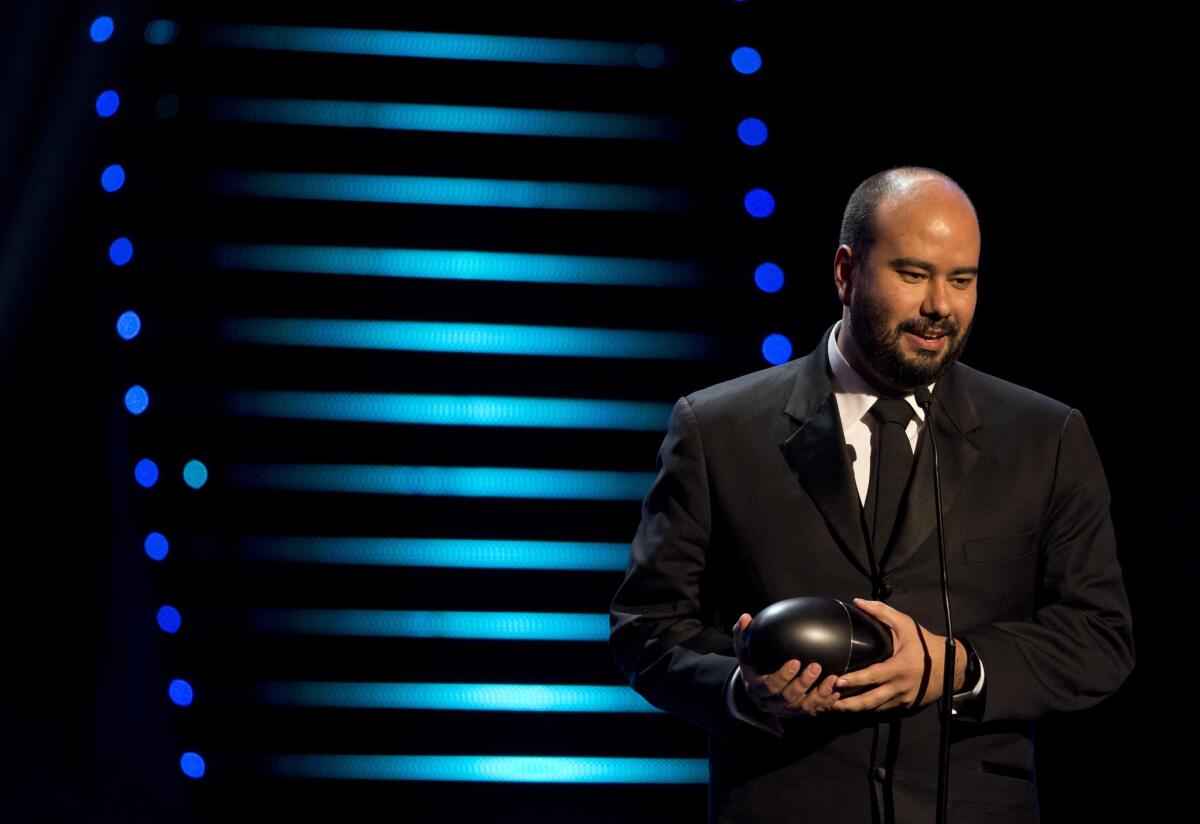Q&A: Sundance 2016: Ciro Guerra on his Oscar-nominated Amazon fable ‘Embrace of the Serpent’
It is like no film about the Amazon that has ever been made — an elegant black-and-white exploration of a fabled landscape that is often shown in lush shades of green. “Embrace of the Serpent,” Colombian director Ciro Guerra’s third feature film, explores the life of a single indigenous man at both the beginning and end of his life.
The story centers around the magnetic Karamakate, a lone survivor of a remote Amazonian ethnicity, who at two different points in his life, finds himself guiding European botanists around the rainforest. The character is played with equal parts ferocity and charisma by two men: Nilbio Torres is the young Karamakate; Antonio Bolivar, the older one. And this is no easy character to portray: Karamakate is a figure who faces the quandary of being the last of his kind.
The film has picked up a multitude of awards at film festivals around the world: from Cannes to Odessa to San Sebastian. In December, Guerra was named one of “10 Directors to Watch” by Variety. Earlier this month, “Embrace of the Serpent” received an Oscar nomination for foreign language film.
“Embrace of the Serpent” is playing in the Spotlight section of this year’s Sundance Film Festival. I caught up with Guerra at the Palm Springs International Film Festival earlier this month, where “Embrace of the Serpent” screened on several occasions. In this lightly edited conversion, he tells me about about how Colombia has historically ignored the Amazon and the ways in which his picture inverts the typical jungle flick.
Your film is an inversion of the typical jungle explorer story, in which the jungle is depicted as this place of darkness — a heart of darkness — that leads men to do crazy or immoral things. I think a lot of Werner Herzog, but also of films such as Francis Ford Coppola’s “Apocalypse Now.”
In the Western tradition, the jungle is a monster that devours men and makes them crazy. For the indigenous people, the jungle is powerful, but at the same time it is indifferent. It’s a place that was there before and will be there after. They love it. That’s the vision they have. So the film is told from that perspective. For the indigenous people, it’s the outsiders that bring the darkness.

Colombian director Ciro Guerra, receiving one of two best director awards at the Fenix Iberoamerican Film Awards in Mexico City in November.
I’d like to know a little bit about the decision to go black and white. The Amazon has such a vivid palette, but in shooting in black and white, you drained it of all color. Why?
The film is inspired by the diaries of the explorers, but also by the photographs they took — those vintage pictures that are almost daguerreotypes. It’s different from the image of the Amazon you have. It doesn’t have that exuberance or the exoticism that you see in the travel brochures. It’s another world, another perspective.
And the idea behind this perspective is very close to the idea of the indigenous perspective of the world — that the world is much bigger than our senses allow us to see. Being there I realized that I wasn’t going to be able to recreate the way the Amazon looks. The indigenous people have 50 words for the word “green.” We have one. In this way, it was possible that the viewer could imagine things — and the Amazon the viewer imagines could be more real than what I could deliver.
I think there is also this view that human beings are somehow separate from nature. That nature is green and we are something else. This avoids that. There were many other reasons. I simply couldn’t have made the picture in color. As we got closer to making it though, there were doubts. The distributors, they were worried it about it being not very commercial, but it’s been quite successful.
What part of the Amazon did you shoot in?
In the northeast Amazon, Vaupés, on the border between Brazil and Colombia, on the Alto Rio Negro. [Botanist Richard Evans] Schultes had spent time studying there. And our inspiration was the Schultes books, his exploration journals.
Yet you specifically chose to tell the story from the point of view of the Indian guide rather than the explorer.
My point of departure was the diaries. But when I went to the Amazon and I started interacting with the people there, I realized that that was the story that hadn’t been told. That’s what we Latin American filmmakers can do. The stories of the explorers have been told. What we can do is turn history on its head, give another perspective.
Had you been to the Amazon prior to developing this project?
I had never been to the Amazon. The previous films I made [such as “The Wind Journeys,” from 2009] were very personal. They were more about family and experience. I wanted to do something unknown to me. And the Amazon — for me and for most Colombians — it’s an area that we speak about very little. In Colombia, they give their backs to the Amazon.
In the Western tradition, the jungle is a monster that devours men and makes them crazy .... For the indigenous people, it’s the outsiders that bring the darkness.
— Ciro Guerra, director
There is a novel, “La Vorágine” [by José Eustasio Rivera]. But since then, there’s been very little cultural production.
People think of the Amazon as a single mass but it varies widely in terms of topography and ecosystems. How did you arrive at the Vaupés?
I did a lot of research. I wanted to see if it was possible to do the film and what film would be possible given the setting. I went to various areas. But I was looking for a jungle that was in a very good state of conservation. A lot of it — the areas that are more accessible, where you can explore — it’s been very affected by agriculture, tourism, commerce, cattle herding. Then we found this region, this place where the rivers aren’t navigable. That’s what has kept it out of the hands of development.

The dialogue is almost entirely in indigenous dialects. Can you tell me a little bit about the ethnicities represented in the film?
Antonio [Bolivar], who plays the older man, he’s one of the last Ocaina. There are less than 15 people who speak the language, so he had this incredible coincidence with the character. But he lived his whole life with the Huitoto. The actor who plays the young Karamakate is Cubeo. They speak in Cubeo and Huitoto and Ticuna and Guarano and Ocaina.
Did you grow up watching jungle films?
Oh, yes. But what I wanted to get across in this film is that the Amazon is so large, that most people in Colombia know more about the jungle of Tarzan than the jungle of Colombia. This has been a dream my whole life, to go there and see it and make a film of that place.
“Embrace of the Serpent” has two remaining screenings at the Sundance Film Festival, on Saturday at 11:59 p.m. at the Broadway Centre Cinema in Salt Lake City and Jan. 30 at the Salt Lake City Library Theatre. It opens in New York on Feb. 17 and Los Angeles on Feb. 19.
Find me on Twitter @cmonstah.
More to Read
The biggest entertainment stories
Get our big stories about Hollywood, film, television, music, arts, culture and more right in your inbox as soon as they publish.
You may occasionally receive promotional content from the Los Angeles Times.











